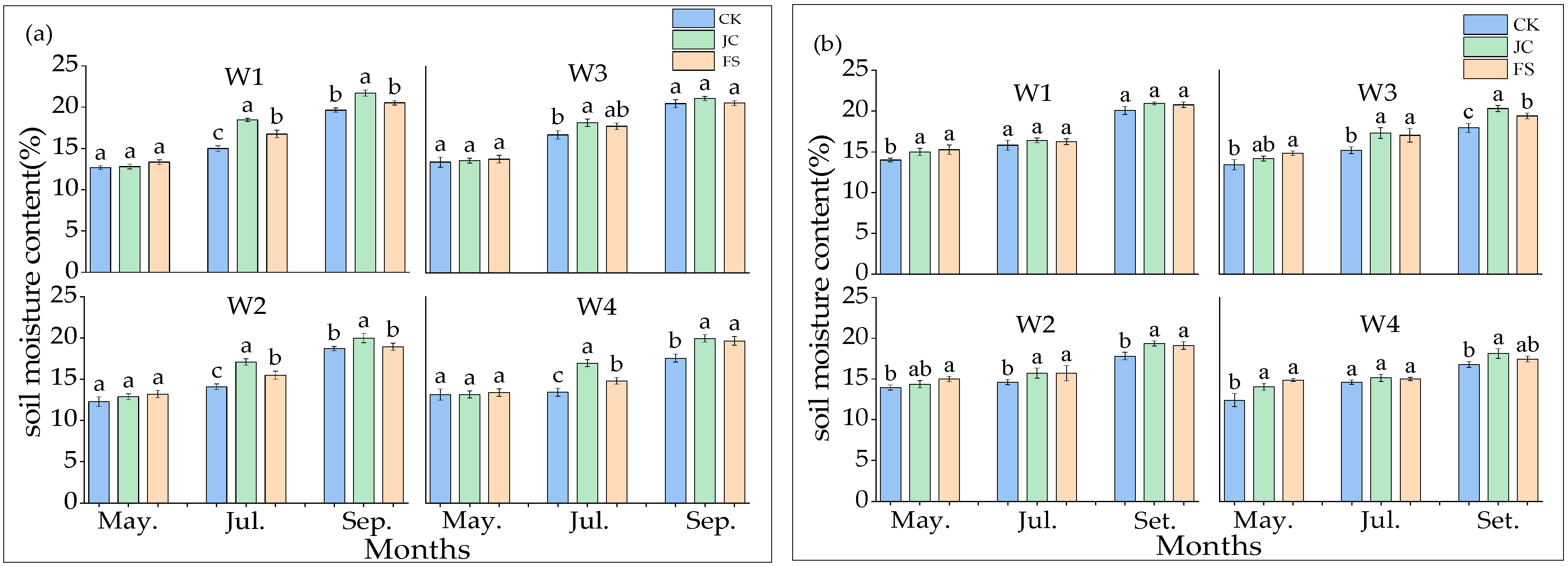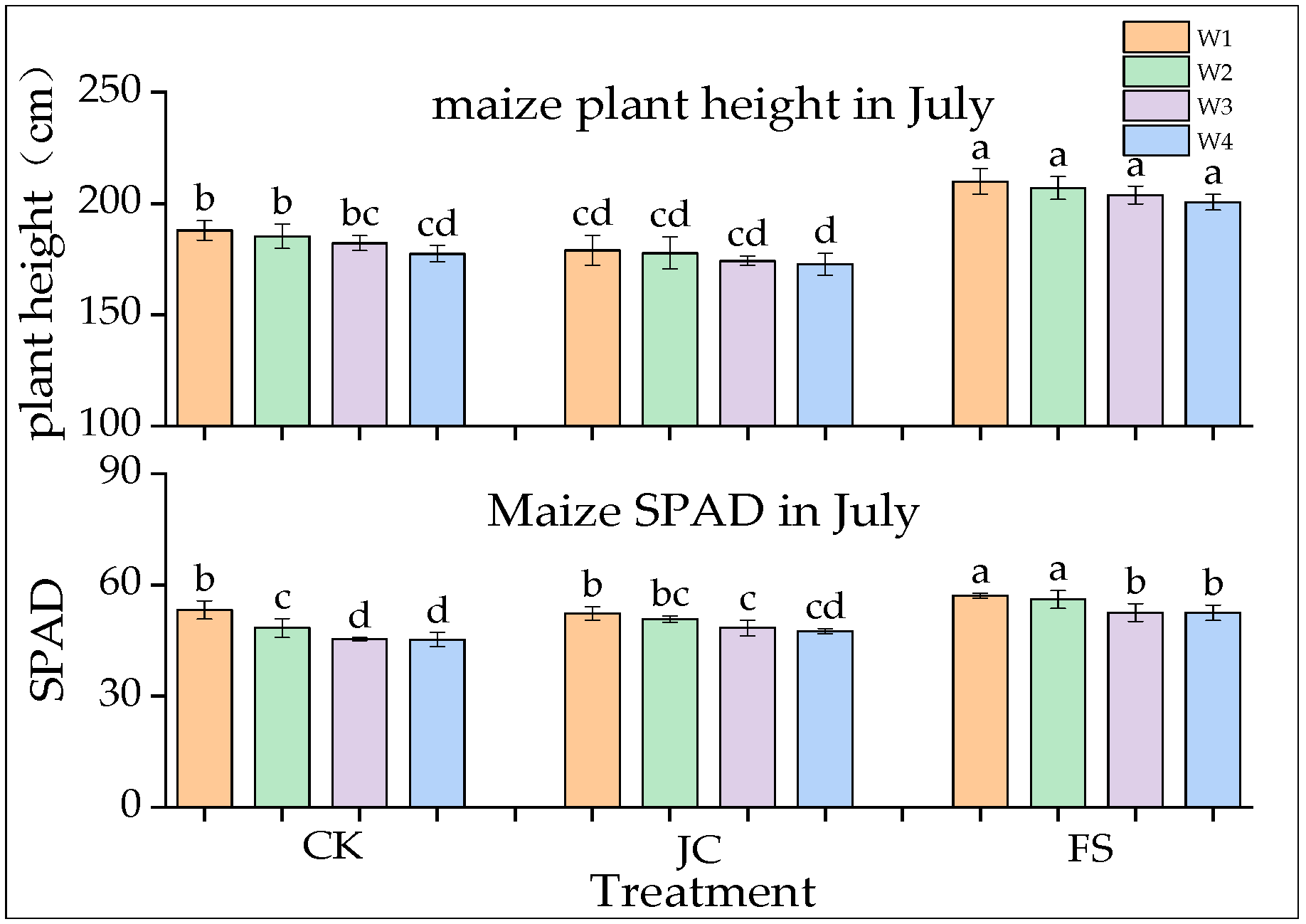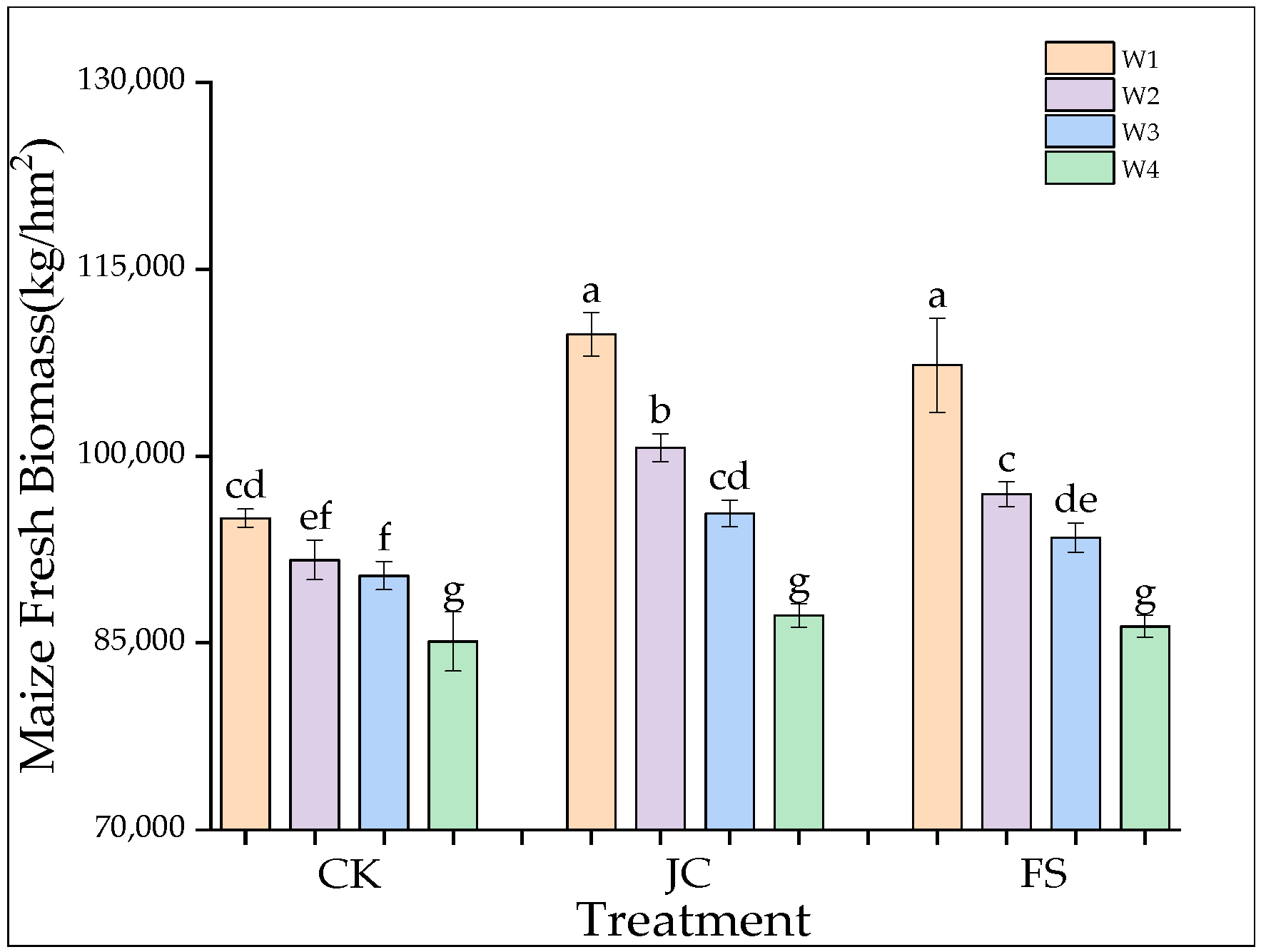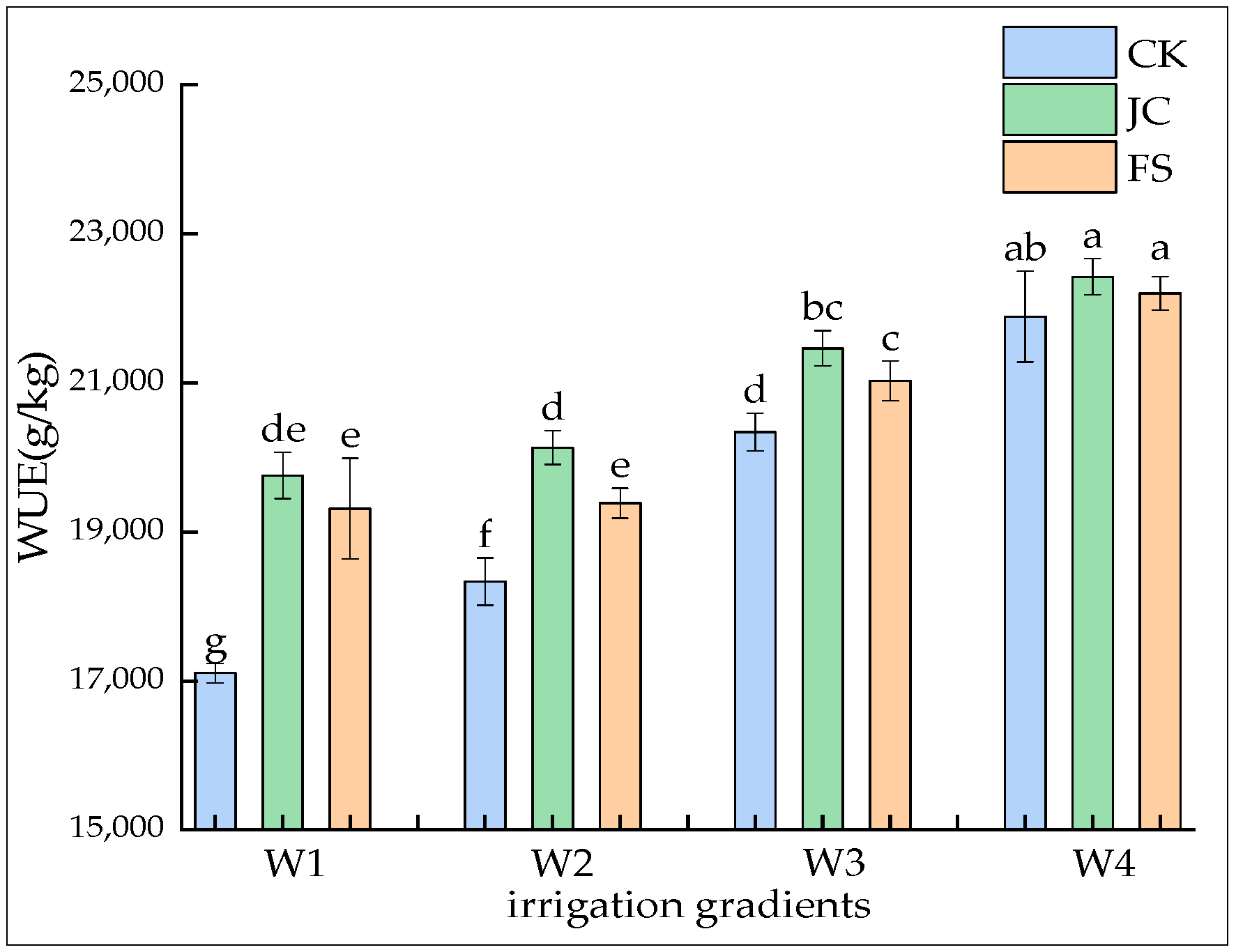Effects of Water-Saving Management Measures on the Water-Salt Properties of Saline–Alkali Soil and Maize Yield in Ningxia, China
Abstract
1. Introduction
2. Materials and Methods
2.1. Overview of the Study Area
2.2. Experimental Design
2.3. Sample Collection and Measurement Methods
2.4. Maize Yield Measurement Method
2.5. Measurement Methods for Each Indicator
2.6. Data Processing and Analysis
3. Results and Analysis
3.1. Effects of Two Different Amelioration Measures on Soil pH in Different Soil Layers Under Different Water Conditions
3.2. The Effect of Two Different Amelioration Measures on Soil EC in Different Soil Layers Under Different Watering Conditions
3.3. The Effect of Two Different Amelioration Measures on Soil Moisture Content in Different Soil Layers Under Different Watering Conditions
3.4. The Effect of Two Different Amelioration Measures on Maize Plant Height and SPAD During the Big-Joint-Leaf Stage Under Different Watering Conditions
3.5. The Effect of Three Different Amelioration Measures on Maize Fresh Biomass and WUE Under Different Watering Conditions
4. Discussion
4.1. Impact of Different Amelioration Measures Under Varying Water Availability Conditions on the Physicochemical Properties of Saline–Alkaline Soil
4.2. Impact of Different Amelioration Measures Under Varying Water Availability Conditions on Maize Fresh Biomass
5. Conclusions
Author Contributions
Funding
Data Availability Statement
Acknowledgments
Conflicts of Interest
References
- Rao, Y.; Peng, T.; Xue, S. Mechanisms of plant saline-alkaline tolerance. J. Plant Physiol. 2023, 281, 153916. [Google Scholar] [CrossRef] [PubMed]
- Yu, F.W.; Dai, M.H.; Lin, S. Cultivated Land Protection Based on Bottom Line Thinking of Food Security: Current Situation, Difficulties and Countermeasures. Econ. Rev. J. 2022, 12, 9–16. [Google Scholar]
- Announcement on the National Cultivated Land Quality Rating in 2019. China Agric. Technol. Promot. 2020, 36, 68–72.
- Bai, X.Y.; Zhang, J.; Cui, Z.L.; Wang, G.J.; Lv, Y.J.; Zhang, F.S. Advances in the Indicator and Assessment Approaches of Medium-low Yield Fields. Acta Pedol. Sin. 2023, 60, 913–924. [Google Scholar]
- Liu, J.X.; Li, Y.; Zheng, Y.M.; Tong, S.J.; Zhang, X.Z.; Zhao, Y.; Zheng, W.; Zhai, B.N.; Wang, Z.H.; Zhang, X.C.; et al. The spatial and temporal distribution of nitrogen flow in the agricultural system and green development assessment of the Yellow River Basin. Agric. Water Manag. 2022, 263, 107425. [Google Scholar] [CrossRef]
- Zhang, W.S. Experimental and Numerical Simulations on the Hydraulic Properties of Salinized Soils in Ningxia Yellow River Irrigation Area under the Action of Different Improvers. Master’s Thesis, North Minzu University, Yinchuan, China, February 2024. [Google Scholar]
- Feng, B.Q.; Cui, J.; Wu, D.; Guan, X.Y.; Wang, S.L. Preliminary studies on causes of salinization and alkalinization in irrigation districts of northwest China and countermeasures. China Water Resour. 2019, 9, 43–46. [Google Scholar]
- Yang, J.S.; Yao, R.J.; Wang, X.P.; Xie, W.P.; Zhang, X.; Zhu, W.; Zhang, L.; Sun, R.J. Prevent soil salinization and improve soil productivity. Science 2021, 73, 30–34+2+4. [Google Scholar]
- Dong, S.D.; Wan, S.Q.; Kang, Y.H.; Li, X.B. Prospects of using drip irrigation for ecological conservation and reclaiming highly saline soils at the edge of Yinchuan Plain. Agric. Water Manag. 2020, 239, 106255. [Google Scholar] [CrossRef]
- Du, Y.; Liu, X.; Zhang, L.; Zhou, W. Drip irrigation in agricultural saline-alkali land controls soil salinity and improves crop yield: Evidence from a global meta-analysis. Sci. Total Environ. 2023, 880, 163226. [Google Scholar] [CrossRef]
- Ondrasek, G.; Rengel, Z. Environmental salinization processes: Detection, implications & solutions. Sci. Total Environ. 2021, 754, 142432. [Google Scholar]
- Li, X.L.; Liu, Q.H.; Liu, X.W.; Hu, J.T.; Yang, J.C.; Cui, D.J. Improving Effect of Different Amendment Treatments in Coastal Saline-Alkali Soil. Bull. Soil Water Conserv. 2015, 35, 219–224. [Google Scholar]
- Bai, X.L.; Wang, B.; Liu, Y.P.; Wang, T.; Zhang, B.H.; Liu, P.T.; Tian, F.; Zhao, H. Combined Application of Amendment Materials Enhances Aggregate Stability and Organic Carbon Content of Saline-Alkali Soil, and Maize Yield in Hetao Irrigation District. J. Plant Nutr. Fertil. 2024, 30, 2082–2092. [Google Scholar]
- Mei, X.; Guo, Y.; Fang, N.; Zhang, Y.; Tang, J. Biostimulants in the bioconversion of organic solid wastes and their agricultural value. Water Wastewater Eng. 2024, 60, 22–28. [Google Scholar]
- Liu, L.; Ma, Y.L.; Yue, F.X.; Qiao, X.X.; Yin, F.; Wang, Y.F. Effects of biochar on nitrogen transformation functional genes abundances, arbuscular mycorrhizal fungi, and N2O emission during the rainfed maize season in cinnamon soil. Acta Ecol. Sin. 2021, 41, 2803–2815. [Google Scholar]
- FAO Global Status of Salt-Affected Soils–Main Report. 2024. Available online: https://openknowledge.fao.org/handle/20.500.14283/cd3044en (accessed on 30 January 2025).
- Bao, S.D. Soil Agrochemical Analysis, 3rd ed.; China Agriculture Press: Beijing, China, 2000. [Google Scholar]
- Xu, D.W.; Wei, Z.M.; Yang, L.; Su, S.X. The rule of sunflower water and soil salinity transport under mulching and different irrigation programs. Water Sav. Irrig. 2018, 11, 86–93. [Google Scholar]
- Yue, Y.P.; Li, H.Y.; Zhang, W.H. Study on the Effects of Desulfurization Gypsum and Humic Acid in Improving Saline-Alkali Soil. Inn. Mong. Sci. Technol. Econ. 2016, 14, 85–87+89. [Google Scholar]
- Li, F.R.; Yang, J.S.; Yao, R.J.; Yu, S.P.; Wu, X.W. Effects of applying gypsum on relationships of electric conductivity among different soil-water extracts of coastal saline soil in North Jiangsu Province. Soils 2014, 46, 1129–1134. [Google Scholar]
- Guo, S.L.; Han, Y.; Wang, A.J.; Chang, X.L.; Wang, T.J. Effect of supplement of biochar in saline land on reducing harmful ions and promoting maize growth. J. Inn. Mong. Norm. Univ. 2022, 51, 494–499. [Google Scholar]
- Yang, H.T. Preparation of Organic Fertilizer from Ganoderma lucidum Residue and Its Improvement Effect on Saline-Alkali Soil; Inner Mongolia University of Science and Technology: Baotou, China, 2023. [Google Scholar]
- Gao, H.Y.; He, X.S.; Geng, Z.C.; She, D.; Yin, J.Y. Effects of biochar and biochar-based nitrogen fertilizer on soil water-holding capacity. Chin. Agric. Sci. Bull. 2011, 24, 207–213. [Google Scholar]
- Kumari, K.G.I.D.; Moldrup, P.; Paradelo, M.; Elsgaard, L.; de Jonge, L.W. Soil properties control glyphosate sorption in soils amended with birch wood biochar. Water Air Soil Pollut. 2016, 227, 174. [Google Scholar] [CrossRef]
- Amini, S.; Ghadiri, H.; Chen, C.; Marschner, P. Salt-affected soils, reclamation, carbon dynamics, and biochar: A review. J. Soils Sediments 2016, 16, 939–953. [Google Scholar] [CrossRef]
- Song, S.S.; Sun, B.P.; Zhang, J.F.; Wu, Y. Effects of water-retaining agent and microbial agent on soil moisture and nutrient content. Arid. Zone Res. 2018, 35, 761–769. [Google Scholar]
- Ouyang, C.H.; Dai, A.M. Report on the Experimental Effects of Fei Zhong Bao Water-Retaining Microbial Fertilizer Applied to Maize. Agric. Dev. Equip. 2017, 1, 95. [Google Scholar]
- Hao, H.B.; Li, C.Y.; Liu, Y.Q. Preparation and properties of humic acid-modified composites with both water absorption and water retention, and slow-release properties of nutrients. J. North Univ. China 2020, 41, 474–480. [Google Scholar]
- Jia, H.; Li, W.H.; Wang, Z.H.; Ding, H.W.; Xu, H. Effects of biodegradable mulching film on soil water evaporation characteristics. Agric. Res. Arid Areas 2020, 38, 1–9. [Google Scholar]
- Li, J.Z. Effects of Degradable Film Mulching and Irrigation Methods on Soil Water and Heat in Paddy Fields and Physiological Growth Characteristics of Rice in Cold Regions; Northeast Agricultural University: Harbin, China, 2023. [Google Scholar]
- Bai, X.; Li, X.Y.; Li, J.L.; Chen, L.M.; Zhang, B.Y. Effects of the combined application of biochar and microbial fertilizer on the properties of substrate and seedling growth of Acer truncatum. Jiangsu Agric. Sci. 2020, 48, 148–154. [Google Scholar]
- Wang, G.; Mehmood, F.; Zain, M.; Hamani, A.K.M.; Xue, J.; Gao, Y.; Duan, A. AquaCrop model evaluation for winter wheat under different irrigation management strategies: A case study on the North China Plain. Agronomy 2022, 12, 3184. [Google Scholar] [CrossRef]
- Hu, Z. Progress in Application Research of Efficient Utilization Technology of Water Resources in Arid Regions. Tech. Superv. Water Resour. 2023, 12, 256–258. [Google Scholar]






| Soil Depth (cm) | pH | EC (µS/cm) | Total Salt (g/kg) | Soil Moisture Content (%) | ESP (%) | CEC | Cl− | SO42− | K+ | Na+ | Ca2+ | Mg2+ |
|---|---|---|---|---|---|---|---|---|---|---|---|---|
| 0~20 | 8.65 | 436.24 | 1.72 | 19.97 | 6.63 | 12.34 | 0.51 | 1.53 | 0.07 | 3.40 | 0.48 | 0.44 |
| 20~40 | 8.50 | 374.82 | 1.53 | 18.89 | 6.35 | 12.18 | 0.35 | 1.51 | 0.10 | 2.83 | 0.36 | 0.46 |
| Maize Fertility Period | Drip Time | Irrigation Water Quantity (mm) | |||
|---|---|---|---|---|---|
| W1 | W2 | W3 | W4 | ||
| Seedling to big trumpet stage | 20 May | 24 | 21.6 | 19.2 | 16.8 |
| 5 June | 24 | 21.6 | 19.2 | 16.8 | |
| 25 June | 24 | 21.6 | 19.2 | 16.8 | |
| Before and after the big trumpet stage | 5 July | 24 | 21.6 | 19.2 | 16.8 |
| 13 July | 24 | 21.6 | 19.2 | 16.8 | |
| 21 July | 24 | 21.6 | 19.2 | 16.8 | |
| 28 July | 24 | 21.6 | 19.2 | 16.8 | |
| Trumpet to maturity | 7 August | 24 | 21.6 | 19.2 | 16.8 |
| 20 August | 24 | 21.6 | 19.2 | 16.8 | |
| 7 September | 24 | 21.6 | 19.2 | 16.8 | |
| pH | EC (µS/cm) | CEC (cmol/kg) | C (g/kg) | N (g/kg) | P (g/kg) | K (g/kg) | |
|---|---|---|---|---|---|---|---|
| desulfurized gypsum | 6.5 | 566 | 23.5 | 5.6 | 6.9 | 4.5 | 0.19 |
| biochar | 6.91 | 929 | 2.47 | 104 | 1.44 | 5.3 | 0.13 |
| humic acid | 6.84 | 1312 | 4.82 | 314 | 58 | 21.2 | 1.16 |
| ETS microbial inoculant | 6.85 | 873 | 2.1 | 251 | 4.1 | 5.4 | 0.15 |
| 0–20 cm Soil Layer | 20–40 cm Soil Layer | |||||||||||
|---|---|---|---|---|---|---|---|---|---|---|---|---|
| May pH | July pH | September pH | May Moisture Content | July Moisture Content | September Moisture Content | May pH | July pH | September pH | May Moisture Content | July Moisture Content | September Moisture Content | |
| Water conditions | * | ns | ns | ** | ** | ** | * | ns | ns | ** | ** | ** |
| Material treatment | ** | ** | ** | ** | ** | ** | ** | ** | ** | ** | ** | ** |
| Water condition × Material treatment | * | ns | ns | ns | ** | ns | * | ns | ns | ** | * | ns |
Disclaimer/Publisher’s Note: The statements, opinions and data contained in all publications are solely those of the individual author(s) and contributor(s) and not of MDPI and/or the editor(s). MDPI and/or the editor(s) disclaim responsibility for any injury to people or property resulting from any ideas, methods, instructions or products referred to in the content. |
© 2025 by the authors. Licensee MDPI, Basel, Switzerland. This article is an open access article distributed under the terms and conditions of the Creative Commons Attribution (CC BY) license (https://creativecommons.org/licenses/by/4.0/).
Share and Cite
Li, T.; Yang, J.; Yao, R.; Zhang, L.; Xie, W.; Wang, X.; Tang, C.; Li, W.; Yang, J.R. Effects of Water-Saving Management Measures on the Water-Salt Properties of Saline–Alkali Soil and Maize Yield in Ningxia, China. Agronomy 2025, 15, 645. https://doi.org/10.3390/agronomy15030645
Li T, Yang J, Yao R, Zhang L, Xie W, Wang X, Tang C, Li W, Yang JR. Effects of Water-Saving Management Measures on the Water-Salt Properties of Saline–Alkali Soil and Maize Yield in Ningxia, China. Agronomy. 2025; 15(3):645. https://doi.org/10.3390/agronomy15030645
Chicago/Turabian StyleLi, Tao, Jingsong Yang, Rongjiang Yao, Lu Zhang, Wenping Xie, Xiangping Wang, Chong Tang, Wenxiu Li, and Jun R. Yang. 2025. "Effects of Water-Saving Management Measures on the Water-Salt Properties of Saline–Alkali Soil and Maize Yield in Ningxia, China" Agronomy 15, no. 3: 645. https://doi.org/10.3390/agronomy15030645
APA StyleLi, T., Yang, J., Yao, R., Zhang, L., Xie, W., Wang, X., Tang, C., Li, W., & Yang, J. R. (2025). Effects of Water-Saving Management Measures on the Water-Salt Properties of Saline–Alkali Soil and Maize Yield in Ningxia, China. Agronomy, 15(3), 645. https://doi.org/10.3390/agronomy15030645






